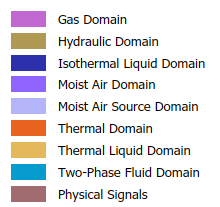Select the Working Fluid
The Simscape™ Fluids™ software enables you to model a variety of isothermal, thermal, and multi-phase systems. Key application areas include fluid transport, power generation, heating and cooling. Simscape Fluids blocks are organized by domain.
Domain Attributes
Component and model attributes depend on the domain:
Isothermal Liquid: Use this domain to model adiabatic liquid systems. This library is based on mass flow rates and uniformly accounts for density as a function of pressure. This domain is best suited for models with little or no variation in temperature, or where changes in fluid viscosity do not significantly influence network dynamics, even if the network is at an elevated or reduced temperature. For more information, see:
Thermal Liquid: Use this domain to model liquid systems with varying temperatures and viscosities, including systems with convective or conductive heat transfer. The fluid properties are functions of pressure and temperature. For more information, see:
Gas: Use this domain to model a perfect, semiperfect, or real gas system. This domain is best suited for applications with one predominant network gas. For more information, see:
Two-Phase Fluids: Use this domain to model systems where the working fluid may be both a liquid and a vapor. This domain does not support more than one fluid in the network. The model is based on the average fluid density in each phase and does not account for opalescence or the separation of liquid and vapor due to gravity. For information on using the two-phase fluid domain, see Model a Refrigeration Cycle.
Moist Air: Use this domain to model air-based systems with water vapor present. This domain is best suited for models where humidity levels or CO2 fluctuations contribute to the dynamics of the system. For more information, see Modeling Moist Air Systems.
Hydraulics (Isothermal): The Hydraulics (Isothermal) library will be removed in a future release. Use the Isothermal Liquid library instead.
The connecting lines and block icons in each network are colored according to its domain:

If there is a functionality in a different domain that you would like to use in your model, consider using an interface block in the Fluid Network Interfaces Library library. These blocks allow you to connect two different networks if conditions are constant over the connection. You can also reduce the simulation time of a two-phase fluid model with an interface connection by making use of the gas and thermal liquid domains in regions where the conditions are constant and have a vapor quality of 1 or 0, respectively.
For example, if you would like to model a rotating channel in a thermal liquid network, and if the temperature does not vary in this region of the model, you can use an Interface (TL-IL) block to connect to a Rotating Channel (IL) block, and then another Interface (TL-IL) block to connect back to the thermal liquid network.
You can also model heat exchange and mass transfer within and between domains using blocks from the Fluid Network Interfaces Library library.
Specify Fluid Properties
A fluid properties block defines the fluid properties of a network. The Simscape Fluids software uses lookup tables to set these fluid properties. If you do not attach a fluid properties block, the domain defaults apply. For default properties, see:
To set the fluid properties in an isothermal liquid network using a fluid properties block, you can either:
Specify any properties by connecting an Isothermal Liquid Properties (IL) block from the Simscape Foundation library. Specify whether the liquid bulk modulus is constant or pressure-dependent and whether the fluid contains entrained air, and, if present, if its amount is constant or pressure-dependent. The default working fluid is water, with constant bulk modulus and zero entrained air.
Connect an Isothermal Liquid Predefined Properties (IL) block from the Simscape Fluids Isothermal Liquid library and select a predefined liquid. You can visualize fluid properties as a function of pressure with this block.
To set the fluid properties in a Thermal Liquid network, you can either:
Specify any properties by connecting a Thermal Liquid Settings (TL) block to the network. This block is in the Simscape Foundation library.
Connect a Thermal Liquid Properties (TL) block from the Simscape Fluids Thermal Liquid library and select a predefined liquid.
To set the properties in a Two-Phase Fluid network, you can either:
Specify any properties by connecting a Two-Phase Fluid Properties (2P) block from the Simscape Foundation library. Specify the properties of liquid and vapor separately, each as a tabulated function of pressure and temperature.
You can provide tabulated data for use in the Two-Phase Fluid Properties (2P) block with the
twoPhaseFluidTablesfunction. This function also allows you to view the properties of the fluid. See Manually Generate Fluid Property Tables for more information.
Connect a Two-Phase Fluid Predefined Properties (2P) block from the Simscape Fluids Two-Phase Liquid library and select a predefined liquid. You can also visualize fluid properties as a function of specific internal energy or specific enthalpy and pressure with this block.
To set the properties in a moist air network, you can specify your own properties by connecting a Moist Air Properties (MA) block from the Simscape Foundation library. You can provide tabulated data for dry air and water vapor and specify the fluid temperature and pressure ranges.
To set the fluid properties in a gas network, you can specify your own properties by connecting a Gas Properties (G) block from the Simscape Foundation library. You can use this block to model a perfect, semi-perfect, or real gas.
See Also
Simscape Block Libraries | Manually Generate Fluid Property Tables